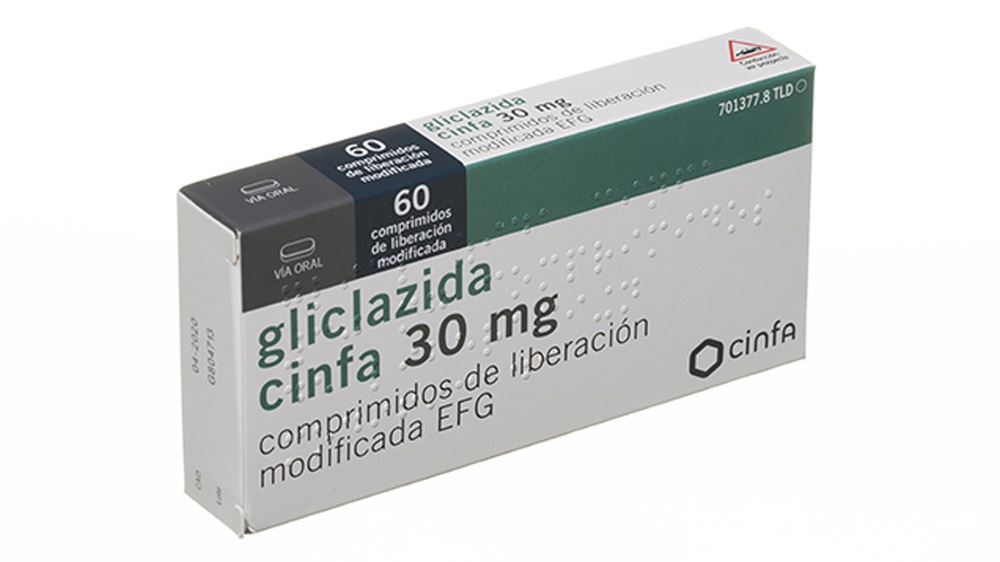

GLICLAZIDE CINFA 30 mg PROLONGED-RELEASE TABLETS

Ask a doctor about a prescription for GLICLAZIDE CINFA 30 mg PROLONGED-RELEASE TABLETS

How to use GLICLAZIDE CINFA 30 mg PROLONGED-RELEASE TABLETS
Introduction
Package Leaflet: Information for the User
Gliclazida Cinfa 30 mg modified-release tablets EFG
Read all of this leaflet carefully before you start taking this medicine because it contains important information for you.
- Keep this leaflet, you may need to read it again.
- If you have any further questions, ask your doctor or pharmacist.
- This medicine has been prescribed for you only. Do not pass it on to others. It may harm them, even if their symptoms are the same as yours.
- If you get any side effects, talk to your doctor or pharmacist. This includes any possible side effects not listed in this leaflet. See section 4.
Contents of the pack
- What Gliclazida Cinfa is and what it is used for.
- What you need to know before you take Gliclazida Cinfa.
- How to take Gliclazida Cinfa.
- Possible side effects.
- Storing Gliclazida Cinfa.
- Contents of the pack and other information.
1. What Gliclazida Cinfa is and what it is used for
Gliclazida Cinfa is a medicine that lowers blood sugar levels (an oral antidiabetic medicine belonging to the sulfonylurea group).
Gliclazida is used in a certain type of diabetes in adults (type 2 diabetes mellitus), when diet, physical exercise, and weight loss alone are not adequate to ensure normal blood sugar levels.
2. What you need to know before you take Gliclazida Cinfa
Do not take Gliclazida Cinfa
- If you are allergic to gliclazide or any of the other ingredients of this medicine (listed in section 6), or to other medicines of the same group (sulfonylureas), or to other related medicines (hypoglycemic sulfonamides);
- If you have insulin-dependent diabetes (type 1);
- If you have ketone bodies and sugar in the urine (which may indicate that you have diabetic ketoacidosis), precoma, or diabetic coma;
- If you have severe kidney or liver damage;
- If you are taking medicines for the treatment of fungal infections (miconazole), see section "Other medicines and Gliclazida Cinfa";
- If you are breastfeeding (see section "Pregnancy and breastfeeding").
Warnings and precautions
Consult your doctor or pharmacist before starting to take Gliclazida Cinfa.
You must follow the treatment prescribed by your doctor to achieve adequate blood sugar levels. This means that, in addition to taking the tablets regularly, you must control your diet, exercise, and, if necessary, lose weight.
During treatment with gliclazide, periodic monitoring of your blood sugar level (and possibly urine) and hemoglobin A1c is necessary.
In the first few weeks of treatment, the risk of low blood sugar levels (hypoglycemia) may increase. Close clinical monitoring is especially necessary.
Low blood sugar levels (hypoglycemia) may occur:
- If you do not maintain regular meals or skip them,
- If you are fasting,
- If you are malnourished,
- If you change your diet,
- If you increase your physical activity without adequate carbohydrate intake,
- If you drink alcohol, especially if you skip meals,
- If you take other medicines or natural remedies at the same time,
- If you take too high doses of gliclazide,
- If you have certain hormonal disorders (functional disorders of the thyroid gland, pituitary gland, or adrenal cortex),
- If your kidney or liver function is severely impaired.
If you experience low blood sugar, you may have the following symptoms: headache, intense hunger, nausea, vomiting, fatigue, sleep disturbances, agitation, aggression, lack of concentration, decreased alertness and reaction time, depression, confusion, visual and speech disturbances, tremors, sensory disorders, dizziness, and vulnerability.
You may also observe the following signs and symptoms: sweating, moist skin, anxiety, rapid or irregular heartbeat, high blood pressure, severe chest pain that may radiate to adjacent areas (angina pectoris).
If your blood sugar levels continue to drop, you may experience severe confusion (delirium), convulsions, loss of self-control, shallow breathing, and slowed heart rate, which can lead to unconsciousness.
In most cases, the symptoms of low blood sugar disappear quickly after consuming sugar, such as glucose tablets, sweets, sugary juice, or sugary tea.
Therefore, you should always carry something sweet with you (glucose tablets, sweets). Remember that artificial sweeteners are not effective. If sugar intake does not help or symptoms recur, please contact your doctor or the nearest hospital.
The symptoms of low blood sugar may not appear, be mild, or develop slowly, or you may not notice in time that your blood sugar level has dropped. This can happen in elderly patients taking certain medicines (e.g., those acting on the central nervous system and beta-blockers).
If you are under stress (accidents, surgical interventions, fever, etc.), your doctor may temporarily switch you to insulin treatment.
The symptoms of high blood sugar (hyperglycemia) may appear when gliclazide has not yet sufficiently lowered blood sugar, when you have not followed the treatment prescribed by your doctor, if you take preparations containing St. John's Wort (Hypericum perforatum) (see section "Other medicines and Gliclazida Cinfa"), or in special stress situations. They may include thirst, dry mouth, dry skin with itching, skin infections, decreased performance, and frequent urination.
If these symptoms appear, you should contact your doctor or pharmacist.
Alterations in blood glucose (low blood sugar and high blood sugar) may occur when gliclazide is prescribed at the same time as other medicines belonging to a class of antibiotics called fluoroquinolones, especially in elderly patients. In this case, your doctor will remind you of the importance of monitoring your blood glucose.
If you have a family history or know that you have a hereditary disorder of glucose-6-phosphate dehydrogenase (G6PD) deficiency (a disorder of red blood cells), a decrease in hemoglobin levels and destruction of red blood cells (hemolytic anemia) may occur. Consult your doctor before taking this medicine.
Cases of acute porphyria have been described with other sulfonylureas in patients with porphyria (hereditary genetic disorders that cause accumulation of porphyrins and porphyrin precursors in the body).
Children and adolescents
Gliclazida should not be used in the treatment of diabetes in children and adolescents under 18 years of age.
Other medicines and Gliclazida Cinfa
Tell your doctor or pharmacist if you are taking, have recently taken, or might take any other medicines.
The hypoglycemic effect of gliclazide may be potentiated, and signs of low blood sugar may appear when taking one of the following drugs:
- other medicines used to treat high blood sugar (oral antidiabetics, GLP-1 receptor agonists, or insulin),
- antibiotics (sulfonamides, clarithromycin),
- medicines for high blood pressure or heart failure (beta-blockers, ACE inhibitors such as captopril or enalapril),
- medicines for fungal infections (miconazole, fluconazole),
- medicines for stomach or duodenal ulcers (H2 receptor antagonists),
- medicines for depression (monoamine oxidase inhibitors),
- analgesics or anti-rheumatics (phenylbutazone, ibuprofen),
- medicines containing alcohol,
- preparations containing St. John's Wort (Hypericum perforatum).
The hypoglycemic effect of gliclazide may decrease, and blood sugar levels may increase if you take any of the following drugs:
- medicines for central nervous system disorders (chlorpromazine),
- anti-inflammatory medicines (corticosteroids),
- medicines for asthma or used during childbirth (intravenous salbutamol, ritodrine, and terbutaline),
- medicines for breast disorders, heavy menstrual bleeding, and endometriosis (danazol).
When a medicine belonging to the class of antibiotics called fluoroquinolones is taken at the same time as gliclazide, alterations in blood glucose (low blood sugar and high blood sugar) may occur, especially in elderly patients.
Gliclazide may increase the effect of medicines that reduce blood clotting (warfarin).
Consult your doctor before taking any other medicine. If you are hospitalized, inform the staff that you are taking Gliclazida Cinfa.
Taking Gliclazida Cinfa with food, drinks, and alcohol
Gliclazida can be taken with meals and non-alcoholic drinks.
Alcohol consumption is not recommended, as it may unpredictably alter your diabetes control.
Pregnancy and breastfeeding
If you are pregnant or breastfeeding, think you may be pregnant, or plan to become pregnant, consult your doctor before taking this medicine.
The use of Gliclazida Cinfa 30 mg is not recommended during pregnancy.
You should not take Gliclazida Cinfa 30 mg if you are breastfeeding.
Driving and using machines
Your ability to concentrate and react may be impaired due to symptoms caused by hypoglycemia or hyperglycemia, such as vision disturbances. This can be dangerous in situations where these skills are important (e.g., driving or using machines). Therefore, consult your doctor if it is advisable to drive or use machines.
Consult your doctor if you can drive in the following cases:
3. How to take Gliclazida Cinfa
Follow exactly the administration instructions of this medicine indicated by your doctor or pharmacist. In case of doubt, consult your doctor or pharmacist again.
The dose will be determined by your doctor, depending on your blood sugar levels and possibly urine. Adjustments in gliclazide doses may be necessary due to changes in external factors (weight loss, lifestyle changes, stress) or improvements in blood sugar control. The recommended daily dose is one tablet per day and may vary from one to four tablets (maximum 120 mg) in a single dose with breakfast. This depends on the response to treatment.
If you start combination therapy with Gliclazida Cinfa 30 mg and metformin, an alpha-glucosidase inhibitor, a thiazolidinedione, a dipeptidyl peptidase-4 inhibitor, a GLP-1 receptor agonist, or insulin, your doctor will determine the appropriate dose of each medicine for you individually.
Contact your doctor or pharmacist if you notice that your blood sugar levels are high despite taking this medicine as prescribed by your doctor.
Method of administration
Oral use.
Swallow the tablets whole. Do not chew or crush them.
Take the tablet(s) with a glass of water at breakfast (preferably at the same time each day). You should always eat after taking the tablets. It is essential that you do not skip any meals while taking gliclazide.
If you take more Gliclazida Cinfa than you should
The symptoms of overdose are those of low blood sugar (hypoglycemia) described in section 2. The symptoms may improve after taking sugar (4 to 6 sweets) or sugary drinks, followed by a substantial snack or meal. If the patient is unconscious, inform your doctor immediately and call the emergency services. The same should be done if someone, for example, a child, has taken the medicine accidentally. Do not give food or drink to unconscious persons.
Make sure that there is always someone informed who can call your doctor in case of an emergency.
In case of overdose or accidental ingestion, consult your doctor or pharmacist immediately or call the Toxicology Information Service, phone 91 562 04 20, indicating the medicine and the amount taken.
If you forget to take Gliclazida Cinfa
It is essential that you take your medicine every day, as regular treatment is more effective.
However, if you forget to take a dose of gliclazide, take the next dose at the usual time. Do not take a double dose to make up for forgotten doses.
If you stop taking Gliclazida Cinfa
Since diabetes treatment is usually for life, you should consult your doctor before stopping this medicine. Stopping treatment could cause an increase in blood sugar (hyperglycemia), which increases the risk of developing diabetes complications.
If you have any further questions about the use of this medicine, ask your doctor or pharmacist.
4. Possible side effects
Like all medicines, this medicine can cause side effects, although not everybody gets them.
The most frequently observed side effect is low blood sugar (hypoglycemia). For symptoms and signs, see section "Warnings and precautions".
If these symptoms are not treated, they may progress to drowsiness, loss of consciousness, or possibly coma. You should seek immediate medical attention if the episode of low blood sugar is severe or prolonged, even if it is temporarily controlled with sugar intake.
Liver disorders
Isolated cases of abnormal liver function have been reported, which can cause yellowing of the skin and eyes. If you experience this, consult your doctor immediately. These symptoms usually disappear after stopping treatment. Your doctor will decide whether it is necessary to stop your treatment.
Skin disorders
Skin reactions such as rash, erythema, itching, hives, blisters, angioedema (rapid swelling of tissues such as eyelids, face, lips, mouth, tongue, or throat that can cause difficulty breathing) have been reported. The rash may evolve into widespread blisters or skin peeling.
If you develop these disorders, stop taking gliclazide, consult your doctor urgently, and tell them that you are taking this medicine.
Exceptionally, signs of severe hypersensitivity reactions (DRESS) have been reported: initially as symptoms similar to flu and a rash on the face, and then a generalized rash with high fever.
Blood disorders
Decreases in blood cell counts (e.g., platelets, red and white blood cells) have been reported, which can cause pallor, prolonged bleeding, bruising, sore throat, and fever. These symptoms usually disappear after stopping treatment.
Gastrointestinal disorders
Abdominal pain, nausea, vomiting, indigestion, diarrhea, and constipation. These effects are reduced when gliclazide is taken with meals, as recommended.
Eyeball disorders
Your vision may be temporarily affected, especially at the start of treatment. This effect is due to changes in blood sugar levels.
As with other sulfonylureas, the following adverse reactions have been observed: severe changes in blood cell counts and allergic inflammation of blood vessel walls, low sodium levels in the blood (hyponatremia), symptoms of liver failure (e.g., jaundice) that in most cases disappeared after withdrawal of the sulfonylurea but may rarely lead to life-threatening liver failure.
Reporting of side effects
If you experience any side effects, talk to your doctor or pharmacist, even if they are not listed in this leaflet. You can also report them directly through the Spanish Pharmacovigilance System for Human Use Medicines: https://www.notificaRAM.es. By reporting side effects, you can help provide more information on the safety of this medicine.
5. Storing Gliclazida Cinfa
Keep this medicine out of the sight and reach of children.
Do not use this medicine after the expiry date stated on the packaging after EXP. The expiry date is the last day of the month indicated.
Do not store above 25°C.
Medicines should not be disposed of via wastewater or household waste. Return the packaging and any unused medicine to a pharmacy for proper disposal. If you have any questions, ask your pharmacist. This will help protect the environment.
6. Package Contents and Additional Information
Gliclazida Cinfa Composition
- The active ingredient is gliclazide. Each modified-release tablet contains 30 mg of gliclazide.
- The other components are: calcium hydrogen phosphate dihydrate, povidone K30, hypromellose K4M PCR, hypromellose K100Prev LV, magnesium stearate, and purified water.
Product Appearance and Package Contents
Gliclazida Cinfa are modified-release tablets, oblong, biconvex, white or almost white in color, engraved with "30" on one side and the other side is smooth.
Gliclazida Cinfa modified-release tablets are available in PVC/aluminum or PVC/Aclar blisters, packaged in boxes of 10, 20, 28, 30, 56, 60, 90, and 120 tablets.
Only some package sizes may be marketed.
Marketing Authorization Holder and Manufacturer
Laboratorios Cinfa, S.A.
Carretera Olaz-Chipi, 10. Polígono Industrial Areta
31620 Huarte (Navarra) - Spain
Date of the Last Revision of this Leaflet:November 2020
Detailed and updated information on this medicinal product is available on the website of the Spanish Agency for Medicines and Health Products (AEMPS) http://www.aemps.gob.es
You can access detailed and updated information about this medicinal product by scanning the QR code included in the leaflet and packaging with your mobile phone (smartphone). You can also access this information at the following internet address: https://cima.aemps.es/cima/dochtml/p/78439/P_78439.html
QR code to: https://cima.aemps.es/cima/dochtml/p/78439/P_78439.html

How much does GLICLAZIDE CINFA 30 mg PROLONGED-RELEASE TABLETS cost in Spain ( 2025)?
The average price of GLICLAZIDE CINFA 30 mg PROLONGED-RELEASE TABLETS in December, 2025 is around 5.59 EUR. Prices may vary depending on the region, pharmacy, and whether a prescription is required. Always check with a local pharmacy or online source for the most accurate information.
- Country of registration
- Average pharmacy price5.59 EUR
- Active substance
- Prescription requiredYes
- Manufacturer
- This information is for reference only and does not constitute medical advice. Always consult a licensed doctor before taking any medication. Oladoctor is not responsible for medical decisions based on this content.
- Alternatives to GLICLAZIDE CINFA 30 mg PROLONGED-RELEASE TABLETSDosage form: MODIFIED-RELEASE TABLET, 30 mgActive substance: gliclazideManufacturer: Les Laboratoires ServierPrescription requiredDosage form: MODIFIED-RELEASE TABLET, 60 mgActive substance: gliclazideManufacturer: Les Laboratoires ServierPrescription requiredDosage form: MODIFIED-RELEASE TABLET, 30 mgActive substance: gliclazideManufacturer: Aurovitas Spain, S.A.U.Prescription required
Alternatives to GLICLAZIDE CINFA 30 mg PROLONGED-RELEASE TABLETS in other countries
The best alternatives with the same active ingredient and therapeutic effect.
Alternative to GLICLAZIDE CINFA 30 mg PROLONGED-RELEASE TABLETS in Poland
Alternative to GLICLAZIDE CINFA 30 mg PROLONGED-RELEASE TABLETS in Ukraine
Online doctors for GLICLAZIDE CINFA 30 mg PROLONGED-RELEASE TABLETS
Discuss dosage, side effects, interactions, contraindications, and prescription renewal for GLICLAZIDE CINFA 30 mg PROLONGED-RELEASE TABLETS – subject to medical assessment and local rules.










